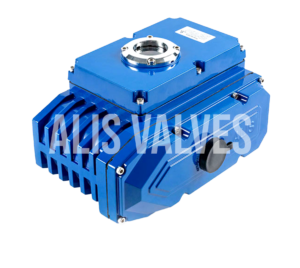Electric vs Pneumatic Actuators: Which is Best for Your Valve Application?
A Comprehensive Comparison to Help You Choose the Right Actuator for Optimal Valve Performance

Actuators play a crucial role in industrial valve automation, controlling the opening and closing of valves with precision. The two most common types of actuators are electric and pneumatic. Selecting between electric and pneumatic actuators can significantly impact the efficiency, safety, and cost-effectiveness of your system. In this article, we’ll explore the differences between these two actuator types, the benefits and drawbacks of each, and the factors to consider when choosing the best option for your valve application.
Understanding Actuators in Valve Applications
Actuators convert energy into motion, enabling valves to open or close as needed in industrial processes. They can be powered by various sources, including electric motors, compressed air (pneumatics), or hydraulic systems. Electric and pneumatic actuators are widely used because they offer different advantages depending on the operational needs of a system.
Choosing the right actuator is essential for optimizing performance, ensuring reliability, and minimizing operational costs. Factors like environmental conditions, operational requirements, safety considerations, and cost will influence your decision.
Electric Actuators: Precision and Control
Electric actuators use an electric motor to create motion, enabling precise control over the movement of the valve. This precision is especially important in industries where accuracy and repeatability are crucial, such as pharmaceuticals, food processing, and power generation.
Advantages of Electric Actuators
- Precision Control: Electric actuators are ideal for applications requiring fine control over valve positioning. They can provide incremental adjustments, making them perfect for throttling applications where the valve must be partially open or closed to regulate flow.
- Energy Efficiency: Once an electric actuator has moved the valve to the desired position, it consumes minimal energy to hold the valve in place, unlike pneumatic actuators, which may need a continuous air supply.
- Ease of Integration: Electric actuators are often easier to integrate with modern control systems. Their compatibility with advanced automation systems, such as SCADA or PLCs, allows for remote monitoring and control.
- Low Maintenance: Electric actuators generally have fewer moving parts compared to pneumatic systems, leading to lower maintenance requirements and reduced downtime for servicing.
- Quiet Operation: Electric actuators operate more quietly than pneumatic systems, making them suitable for environments where noise is a concern.

Disadvantages of Electric Actuators
- Slower Response Time: Electric actuators tend to be slower than pneumatic actuators in opening or closing a valve, which can be a limitation in applications requiring rapid actuation.
- Higher Initial Cost: The upfront cost of electric actuators is typically higher compared to pneumatic systems, although their lower maintenance costs and energy efficiency may offset this over time.
- Limited for High Force Applications: While electric actuators excel in precision, they may not be the best option for applications requiring very high force or torque, such as in heavy-duty industrial applications.
- Sensitivity to Environmental Conditions: Electric actuators can be affected by extreme environmental conditions such as high temperatures, humidity, or corrosive atmospheres, which may require additional protective measures.
Pneumatic Actuators: Power and Simplicity
Pneumatic actuators use compressed air to create motion, making them well-suited for industries that already use compressed air systems, such as manufacturing, oil and gas, and chemical processing. Pneumatic actuators are known for their simplicity, reliability, and ability to generate high force.
Advantages of Pneumatic Actuators
- High Force Output: Pneumatic actuators can generate large amounts of force relative to their size, making them ideal for applications requiring quick and powerful motion, such as in heavy industrial processes.
- Fast Response Time: Pneumatic actuators can open or close valves quickly, which is crucial in emergency situations or when rapid actuation is needed for process control.
- Simplicity and Durability: Pneumatic actuators are mechanically simple, making them robust and durable. They can operate reliably in harsh environments, including extreme temperatures, dusty or dirty conditions, and potentially explosive atmospheres.
- Cost-Effective for Simple Applications: Pneumatic systems tend to have lower upfront costs than electric systems, especially when compressed air is already available in the facility. They also tend to be more cost-effective for applications requiring only on/off control, rather than precise positioning.
- Fail-Safe Capabilities: Pneumatic actuators can be designed to default to a fail-safe position (open or closed) in the event of power or air supply failure, providing an extra layer of safety in critical applications.
Disadvantages of Pneumatic Actuators
- Energy Inefficiency: Pneumatic actuators require a continuous supply of compressed air to function, which can be less energy-efficient compared to electric actuators, especially if the system is not optimized for air use.
- Limited Precision: While pneumatic actuators excel in on/off control, they are less effective for applications requiring fine control or throttling. They generally lack the precision and adjustability that electric actuators offer.
- Higher Operating Costs: Due to the need for a continuous air supply, pneumatic systems can have higher long-term operating costs, especially in applications where the valve needs to stay in a certain position for long periods.
- Environmental Impact: Air leaks in pneumatic systems can be common, leading to inefficiency and environmental impact due to wasted energy. This can result in higher costs over time as well.
Factors to Consider When Choosing Between Electric and Pneumatic Actuators
- Application Requirements: The most critical factor is the nature of your application. For example, if precision control is vital, electric actuators are the better choice. For rapid response in heavy-duty applications, pneumatic actuators may be more suitable.
- Environmental Conditions: Consider the operating environment. Pneumatic actuators are more robust in harsh conditions, while electric actuators may require additional protection against moisture, dust, and temperature extremes.
- Cost Considerations: While pneumatic actuators generally have a lower initial cost, electric actuators can offer savings in energy efficiency and maintenance over time. Evaluate both the upfront and long-term costs.
- Energy Availability: If compressed air is readily available at your facility, pneumatic actuators may be more practical. If not, electric actuators are more straightforward to implement, especially in modern facilities with integrated electrical systems.
- Maintenance and Downtime: Electric actuators often require less maintenance, reducing downtime in critical applications. However, pneumatic actuators are known for their simplicity and durability, especially in rugged environments.
- Safety: Pneumatic actuators offer inherent fail-safe capabilities, which can be critical in certain industries, such as oil and gas or chemical processing. Electric actuators may need additional backup power systems to provide similar safety features.
Conclusion
When choosing between electric and pneumatic actuators for your valve application, there is no one-size-fits-all solution. Each has its own strengths and weaknesses, and the decision should be based on your specific operational needs, environmental conditions, and cost considerations. Electric actuators offer precision, energy efficiency, and ease of integration, while pneumatic actuators provide power, speed, and robustness in harsh environments. By carefully evaluating your system’s requirements, you can select the actuator that best fits your needs and ensures optimal valve performance.



